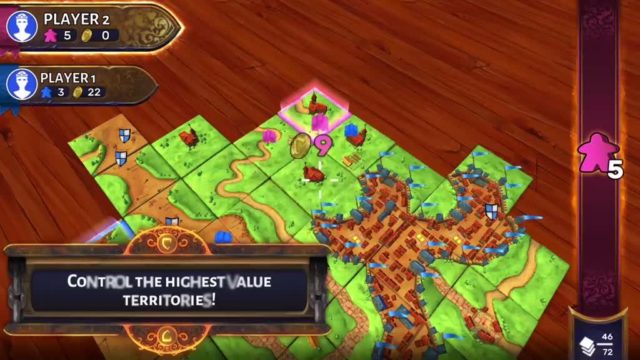Competent reproduction of a classic game; intuitive controls; available online play
Tutorial could be more comprehensive; no touch screen controls; some content requires a separate purchase
In 1995, a pair of German designers created a board game known in the English-speaking world as Settlers of Catan. Over three decades later, the game has sold over 22 million copies in 30 languages, spawned a number of spinoffs and expansions, and shortened its name to Catan. Various incarnations of Catan have been released on a number of different platforms going back to the 1990s, including PC, Mac, Kindle, PlayStation 3, Xbox 360, web browser, VR, and, for those who remember it, N-Gage. Catan also previously appeared in a form on Nintendo DS back in 2009. Now Catan is available for Switch, for $19.99 as a digital purchase. It includes the core Catan game, as well as scenarios based on the Seafarers expansion. Players can also download the Cities and Knights expansion for $5.99.
Catan has a simple but classic feel. The graphics showcase cartoon-style opponents on a medieval-inspired game board, with the kind of understated action on-screen that you’d expect from a board game turned video game. The music is similarly classical, a minor keyed theme that takes its riff from the likes of, say, Game of Thrones or any number of Western dungeon-crawlers. The controls are nicely designed, with an intuitive button mapping that makes gameplay pretty easy. In particular, the game puts the ZL and ZR buttons to nice use, making decision-making swift. The game also requires players to hold a button down for a second or two to confirm a decision, which helps reduce the risk of accidentally making the wrong choice. It would have been nice to have touch screen controls, which, sadly, are not supported.

Single player has three modes: tutorial, campaign, and scenario. The tutorial walks players through the basics of the game. It’s crucial for anyone who hasn’t played Catan before (or played it in a long time) but it also doesn’t cover every nuance of the game, so new players may want to visit the game’s almanac for additional insight. The campaign mode allows players to venture from scenario to scenario, trying out different configurations of the game board. The campaign operates under the guise of a story, although the narrative thread is pretty thin. Mostly, it’s just about mastering specific scenarios against opponents before moving on to other scenarios against other opponents. The scenario mode basically lets players choose from scenarios previously unlocked in campaign mode. The principal difference from campaign mode is that you can tweak the rules, like setting a turn timer or allowing the robber piece to steal from the player who rolled it.
The difficulty of the AI in the single player mode can be adjusted among three levels. At the lowest level, AI players can be both annoying and dumb, pestering you repeatedly for the same trade while making head-scratching decisions. The higher levels are more formidable.

Catan can be played in both single player and online multiplayer. (Offline multiplayer is not supported- it would be hard to do so, given that players would see each other’s hands- and local wireless is also not supported.) Online multiplayer can be set up either by custom match or by an auto match. You must have an active Nintendo Online account to use the online component. The number of available opponents depends on the time of day, although it probably goes without saying that auto match is a better bet for finding others to play against. In the spirit of Nintendo’s online vision, communication with others is limited to emoji-like images, including one to pester your opponents to hurry up if they’re being too slow.
Overall, Catan is a competent reproduction of the popular board game on Switch. It’s understated in some ways as board game-based games are, but it also has a lot of variety to the game, including various offline scenarios and an online multiplayer mode through Nintendo Online. Available DLC adds more to the package.
Nintendojo was provided a copy of this game for review by a third party, though that does not affect our recommendation. For every review, Nintendojo uses a standard criteria.




 ShareThis
ShareThis





